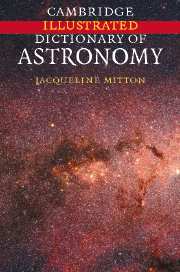Summary
Baade, (Wilhelm Heinrich) Walter (1893–1960) Walter Baade was born in Germany and began his astronomical career at the Bergedorf Observatory of the University of Hamburg. While there, he discovered the unusual asteroid ➤ Hidalgo. In 1931 he moved to the ➤ Mount Wilson Observatory in California where he worked until his retirement. He discovered a total of 10 asteroids, including ➤ Icarus.
In the 1940s, he used the 100-inch telescope at Mount Wilson to resolve individual stars in the ➤ Andromeda Galaxy and two of its small companion galaxies. This led him to divide stars into two broad groups, ➤ Population I and ➤ Population II. He realized that Population I had the characteristics of young stars while population II was older. He also found that each population had its own kind of ➤ Cepheid variable star. Cepheids had been used incorrectly to judge the distance of the Andromeda Galaxy and Baade showed that it was twice as far away as previously thought. In the 1950s he worked on identifying radio sources, including ➤ Cygnus A.
Baade's Window An area of sky around the globular cluster NGC 6522 in the constellation Sagittarius, which is particularly rich in stars. The astronomer Walter ➤ Baade drew attention to it. He realized that very distant stars are visible in that direction because there is relatively little interstellar material to hide them.
Baikonur The Russian manned space-flight center, established by the former Soviet Union. It is situated north-east of the Aral Sea in Kazakhstan.
- Type
- Chapter
- Information
- Cambridge Illustrated Dictionary of Astronomy , pp. 32 - 46Publisher: Cambridge University PressPrint publication year: 2007
- 1
- Cited by



